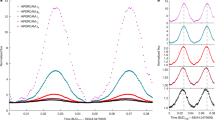Abstract
THE pulsar 1829–10 has a remarkable companion1 of only ∼10 Earth masses, which occupies a nearly circular orbit of 184-day period. Bailes et al.1 speculate that this companion is a planet which has either survived the earlier stellar evolution and supernova which created the pulsar, or else formed through some sort of coagulation process during the lifetime of the pulsar. I argue here that another interpretation, which they excluded, may actually be more plausible: that the companion began its life as a star, and has been ablated down to its present mass by absorbing a portion of the pulsar's spindown energy. That similar phenomena have already been seen in two other binary pulsars, PSR 1957 + 20 (refs 2, 3) and PSR 1744–24A (refs 4, 5), lends preliminary credence to this suggestion. The (surprisingly small) final mass of the remnant is determined by the interplay between decreasing spin-down luminosity, recession of the companion from the pulsar as a result of its mass loss, and, most importantly, shrinkage of the companion due to convective cooling of its interior.
This is a preview of subscription content, access via your institution
Access options
Subscribe to this journal
Receive 51 print issues and online access
$199.00 per year
only $3.90 per issue
Buy this article
- Purchase on Springer Link
- Instant access to full article PDF
Prices may be subject to local taxes which are calculated during checkout
Similar content being viewed by others
References
Bailes, M., Lyne, A. G. & Shemar, S. L. Nature 352, 311–313 (1991).
Fruchter, A. S., Stinebring, D. R. & Taylor, J. H. Nature 333, 237–239 (1988).
Fruchter, A. S. et al. Astrophys. J. 351, 642–650 (1990).
Lyne, A. G. et al. Nature 347, 650–652 (1990).
Nice, D. J., Thorsett, S. E., Taylor, J. H. & Fruchter, A. S. Astrophys. J. 361, L61–L63 (1990).
van den Bergh, S. Astrophys. J. 327, 156–163 (1988).
Verbunt, F. in Neutron Stars and their Birth Events (ed. Kundt, W.) 179–218 (Kluwer, Dordrecht, 1990).
Zahn, J.-P. Astr. Astrophys. 57, 383–394 (1977).
Ruderman, M., Shaham, J. & Tavani, M. Astrophys. J. 336, 507–518 (1989).
Phinney, E. S., Evans, C. R., Blandford, R. D. & Kulkarni, S. R. Nature 333, 832–834 (1988).
Michel, F. C. Nature 337, 236–238 (1989).
Eichler, D. & Levinson, A. Astrophys. J. 335, L67–70 (1988).
Krolik, J. H. & Sincell, M. W. Astrophys. J. 357, 208–215 (1990).
Clayton, D. D. Principles of Stellar Evolution and Nucleosynthesis, 224 (McGraw-Hill, New York, 1968).
Zapolsky, H. S. & Salpeter, E. E. Astrophys. J. 158, 809–813 (1969).
Ryba, M. & Taylor, J. H. (1991). Princeton University preprint.
Mihalas, D. Stellar Atmospheres, 187 (Freeman, New York, 1978).
Author information
Authors and Affiliations
Rights and permissions
About this article
Cite this article
Krolik, J. Creation by stellar ablation of the low-mass companion to pulsar 1829–10. Nature 353, 829–831 (1991). https://doi.org/10.1038/353829a0
Received:
Accepted:
Issue Date:
DOI: https://doi.org/10.1038/353829a0
This article is cited by
-
Planets around pulsars: A review
Astrophysics and Space Science (1994)
-
A planetary system around the millisecond pulsar PSR1257 + 12
Nature (1992)
Comments
By submitting a comment you agree to abide by our Terms and Community Guidelines. If you find something abusive or that does not comply with our terms or guidelines please flag it as inappropriate.



